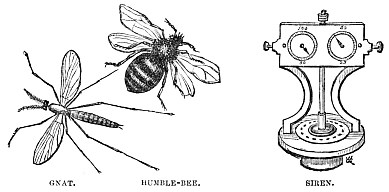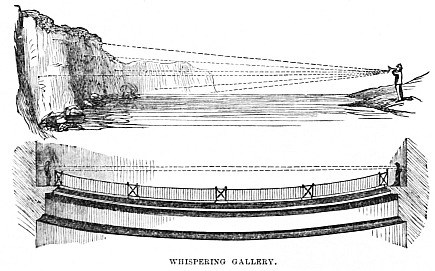 полная версия
полная версияNature's Teachings
The reader will observe that at the lower part of the instrument there is a disc pierced with a number of holes, and that above these are two dials. Below the perforated disc, and therefore unseen, is a circular plate, also pierced with holes. When a pipe is attached to the lower part of the instrument, and air propelled through it, the disc begins to revolve, every revolution being recorded by the dials, after the fashion of the ordinary gas-meter.

As the pressure is increased, the air, passing through the holes, assumes a rhythmical beat, which soon becomes metamorphosed into musical notes. It is evident, therefore, that, by means of this instrument, the number of vibrations which produce a definite tone can be measured with absolute accuracy by any one who has an ear capable of appreciating a musical note.
It is by means of the Siren that the much-disputed tonic of C will be settled, the Continental and the English C being greatly at variance, and even the English C having been advanced almost a tone since the time of Handel. Much is it to be wished that Italy, the home of song, and England, the patron of song, could unite in their tonic, instead of having systems so widely different that an Italian singer is at a loss with the English pitch, as is an English singer with the Italian pitch.
The Siren is even brought into the service of entomologists, enabling them to measure by the sound the rapidity with which a flying insect moves its wings. By means of this instrument we know the origin of the sharp, piercing “ping” of the Gnat, and the heavy, dull boom of the Humble-bee, both of which insects are given in the illustration.
Before taking leave of this subject, I may mention that the instrument is called the Siren because it sings as well under water as in the air, provided that water instead of air be driven through it.
EchoOur last page will be given to the phenomenon called by the name of Echo, which consists in the power of solid substances, whether natural or artificial, of reflecting the waves of sound thrown against them, just as a mirror reflects the waves of light.

Very often the Echo is naturally formed, as shown in the illustration, by rocks which cast back the sound—waves thrown against them. This is the case in several parts of Dovedale in Derbyshire, where a pistol shot is reverberated backwards and forwards in a most wonderful manner, and a trumpet blast repeats itself over and over again.
At Walton Hall, the residence of the late C. Waterton, Esq., there is a wonderful Echo, nearly half a mile from the house. Mr. Waterton had discovered the Echo, which proceeded from the walls of the house, and, having found its focus, placed on it a large stone, called the Echo-stone. Any one sitting on this stone, and singing, speaking, or whistling towards the house, heard every sound repeated, as if in mockery.
The celebrated Whispering Gallery in St. Paul’s Cathedral is nothing but an ordinary Echo, though so intensified by the process of radiation, that the sound is transmitted from one side of the dome to the other, just as light or heat is reflected from concave mirrors.
1
By sailors the Velella is popularly known by the name of “Sally-man;” i.e. Sallee-man.
2
Now Sir Henry J. Burford Hancock, Chief Justice of Gibraltar.






